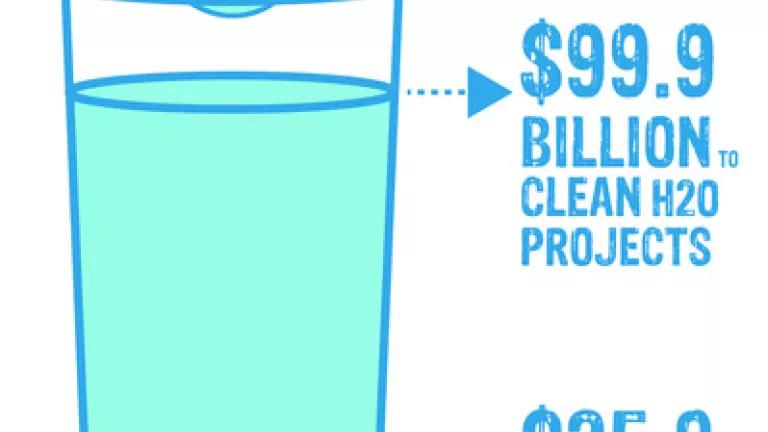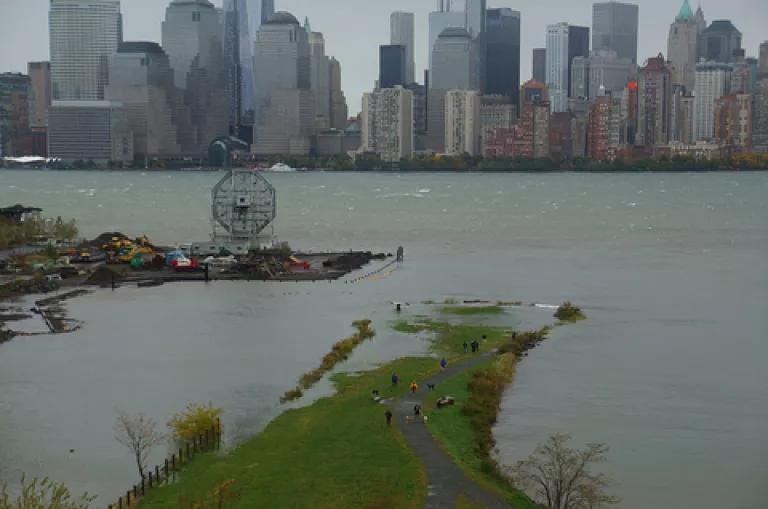
Water and wastewater infrastructure systems play a vital role in our daily lives. Without these critical systems, life as we know it would not be possible. Yet much of this infrastructure is outdated, under-maintained, and in desperate need of repair. Over the next 20 years, water infrastructure needs across the U.S. are estimated to total more than $630 billion simply to maintain current levels of service. Further, recent crippling events like Hurricane Sandy illustrate the toll that extreme weather can wreak on these systems and our communities. These impacts seriously threaten public health, water availability and quality, and devastate homes and infrastructure.
Fortunately, federal funding programs like the Clean Water and Drinking Water State Revolving Funds (SRFs) are available to help communities make investments in sensible 21st century water solutions that also help prepare for the worst effects of climate change. In our new issue paper, Using State Revolving Funds to Build Climate-Resilient Communities, we share how states and municipalities can better integrate water efficiency, green infrastructure, and flood resiliency into the SRFs to ensure a safe, sufficient water future. We also discuss the legal authority for states to implement these recommendations and provide examples of states and municipalities already experiencing successes with these approaches.
Since their creation, the SRFs have collectively financed more than $125 billion of public health and water quality protection projects across the country. While the SRFs also can be used to make water and wastewater infrastructure more resilient to flooding, drought, and other climate change risks, SRF loans and grants have been underutilized for these much-needed purposes. In fact, these risks are not routinely considered, increasing the likelihood that climate change will either render SRF projects inadequate or make them more vulnerable to damage.
States can address this urgent need for modernizing water infrastructure by implementing water efficiency, green infrastructure, and flood resiliency policies to ensure that projects receiving SRF support adequately consider climate risks and incorporate proactive solutions. In fact, Governor Pat Quinn signed legislation today that will enable Illinois communities to use SRF financing to implement innovative green infrastructure, water efficiency, and other climate-smart projects. And President Obama just last week announced a slate of federal actions, including on green infrastructure, to help communities prepare for climate change impacts. By embracing these approaches, states and local municipalities can maximize the value of existing SRF dollars to ensure that wise investments in water and wastewater infrastructure better prepare us for the future, and in turn, make our communities more resilient.
Water Efficiency

Water-efficient landscaping in Dallas, TX (credit: Paul Schattenberg)
Water conservation and efficiency measures can cost-effectively lower water demand, improve the reliability of existing supplies, delay capital expenditures for new water infrastructure, and reduce energy demands associated with the treatment and delivery of water and wastewater. As my colleague Larry Levine explains, these measures also can cost-effectively help municipalities comply with the Clean Water Act. Specifically, states can better integrate water efficiency into the SRFs by:
- Promoting the availability of SRF support for water conservation plans, projects, and programs;
- Requiring water and wastewater utilities to adopt comprehensive water conservation plans or specific policies or programs as a condition for funding;
- Requiring that projects seeking funding (1) evaluate water conservation alternatives, (2) include any measures that reduce the net capital/operating costs of the project, and (3) incorporate the resulting flow reductions into the design of the overall project; and
- Ensuring that designs of new, replacement, or expanded infrastructure are based on the most current data and projections of per capita water demand.
Green Infrastructure

Planter boxes and porous pavement in Washington, DC (credit: Dan Reed)
Green infrastructure techniques can reduce flood risks associated with heavy rainfall events. These techniques use soils and vegetation in urban areas to absorb runoff where it falls, limiting flooding and sewer backups. Green roofs, rain gardens, roadside plantings, porous pavement, and rainwater harvesting not only reduce flooding and protect water quality, they also transform rainwater from a source of pollution into a valuable resource. States can increase SRF support for green infrastructure projects by:
- Assigning a higher priority to green infrastructure projects on the Project Priority List through modification of state scoring criteria;
- Requiring that projects intended to reduce sewer overflows or improve stormwater management evaluate and implement all cost-effective green infrastructure measures;
- Promoting the availability of SRF support for green infrastructure projects and programs; and
- Committing to using a certain percentage of SRF project assistance for green infrastructure projects and programs.
Reducing Flood Risks

Flooding from Sandy at Morris Canal Park, Jersey City, NJ (credit: Augie Ray)
Water infrastructure is particularly vulnerable to flood risks from more extreme rainfall events and sea level rise. Intense rainfall and coastal storm surges threaten water management and flood control infrastructure, increasing risks for treatment plants and other facilities and jeopardizing service reliability. Wastewater infrastructure is particularly at high risk due to their typically low elevation. States can implement several measures to ensure that SRF projects adequately consider existing and future flood risks to help reduce damages, decrease service interruptions, and minimize threats to public health and safety:
- Promote the availability of SRF support for flood risk reduction measures that better protect water and wastewater infrastructure;
- Avoid funding water and wastewater infrastructure projects in the 500-year floodplain whenever possible;
- Require protection against either the 500-year flood event or the highest historical flood event—whichever is greater—for projects located in the 500-year floodplain;
- Require that projects proposed in coastal floodplain areas consider and protect against sea level rise-related flooding and storm surge risks; and
- Require that projects use natural and green infrastructure solutions to reduce flood risks.
